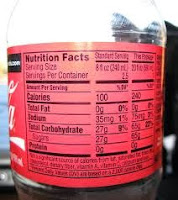Soda also known as soft drinks or carbonated drinks or soda pop is a beverage containing carbonated water, sweetener and flavoring. At times it may also contain caffeine, coloring, preservatives among other ingredients. The main interest of this article is the ingredients of soda and how much of these ingredients should we really consume. Also to be noted that this article is not targeting a particular brand but will be based on the nutrition facts label samples that are available to me at the time of writing this article.
So first things first....
WHAT IS A NUTRITION FACTS LABEL?
A nutrition facts label also known as nutrition facts panel is usually that part of food packaging which contains ingredients data, how much is there and so on and so forth... Link below can be useful in learnig how to use one: LABELING AND NUTRITION- FDA
The images above are some examples of nutrition facts label on soft drinks.
THE ANALYSIS OF SODAS IN OUR MARKET
In this article I am going to analyze the two brands whose picture I have uploaded below so as to enable us to scrutinize soft drinks keenly before we buy them.
 |
| LABEL 1 |
 |
| LABEL2 |
Label 1 is a carbonated soft drink whose ingredients include carbonated water, sugar, acidulant (citric acid0, stabilizers (E414, E444, E445), preservative (sodium benzoate), flavoring, coloring (sunset yellow and carmoisine), antioxidant (ascorbic acid). Per 250ml that is a glass of this particular label you get 136kcal, 34gm of sugar, no fat, no saturates and 7.1mg of sodium whose percentage recommended daily allowance (RDA/GDA) is based on a 2000kcal diet.
Label 2 on the other hand is also a carbonated soft drink whose ingredients are carbonated water, sugar, acidulants( citric acid and sodium citrate), flavoring, preservastive( sodium benzoate). Per 250ml you get 105kcal, 25.5gm of sugar, no fat, no saturates and 11mg of sodium whose % GDA is based on a 2000kcal diet.
Now let as begin with the dietary bit first. If you are to drink 2 glasses of soda lets say label 1 you would have already had 272kcal which is almost a quarter of the Kilocalories that you need for the day am so sure you wont be feeling full only that you would have quenched your thirst and also achieved a bit of you fluid requirements for the day. For those watching their weights and are very strict on their calories but cant keep off this you remain feeling hungry and lesser the satiety the more likely your diet plan is to fail cause of temptations. As for the sodium well it is quite withing your reach for now but for the kidney disease patients out there may be you can only afford 2 sessions of dialysis per week mostly even once so you better watch out on the sodium there. In comparison of the two labels 1 may offer more calories less of sodium where as 2 offers less calories and more sodium so on an individual basis you know yourself best to know where the scale would fall.
Now we get into the common ingredients, "the chemicals added"
CARBONATED WATER
According to Wikipedia it is water into which carbon dioxide gas under pressure has been dissolved mainly used in making fizzy drinks like mineral water and soft drinks. It has several health benefits like increased water intake, resolving issues of indigestion and reduction of cholesterol and cardiovascular risks. However it is said to worsen irritable bowel syndrome.
PRESERVATIVE (SODIUM BENZOATE)
Sodium benzoate is a widely used food preservative, with E number E211. It is the sodium salt of benzoic acid and exists in this form when dissolved in water. It can be produced by reacting sodium hydroxide with benzoic acid. Benzoic acid occurs naturally at low levels in cranberries, prunes, greengage plums, cinnamon, ripe cloves, and apples (REF: WIKIPEDIA).
In combination with ascorbic acid (vitamin C, E300), sodium benzoate and potassium benzoate may form benzene, a known carcinogen. When tested by the FDA, most beverages that contained both ascorbic acid and benzoate had benzene levels that were below those considered dangerous for consumption by the World Health Organization . Most of the beverages that tested higher have been reformulated and subsequently tested below the safety limit. Note the Coca-cola company is said to have noted such issues and is stick to very low levels of this preservative till a safer alternative has been found. Heat, light and shelf life can increase the rate at which benzene is formed. Also there are claims of combinations of some food colorings and sodium benzoate to cause hyperactivity in children.
You can also read more on this and other common food additives on FOOD ADDITIVES WEBMD.
This articles is to be continued soon as i research more the remaining ingredients. please if you have any queries feel free to contact me through my facebook page Nutrisavvy Solutions or leave a comment below.
TO BE CONTINUED....




No comments:
Post a Comment